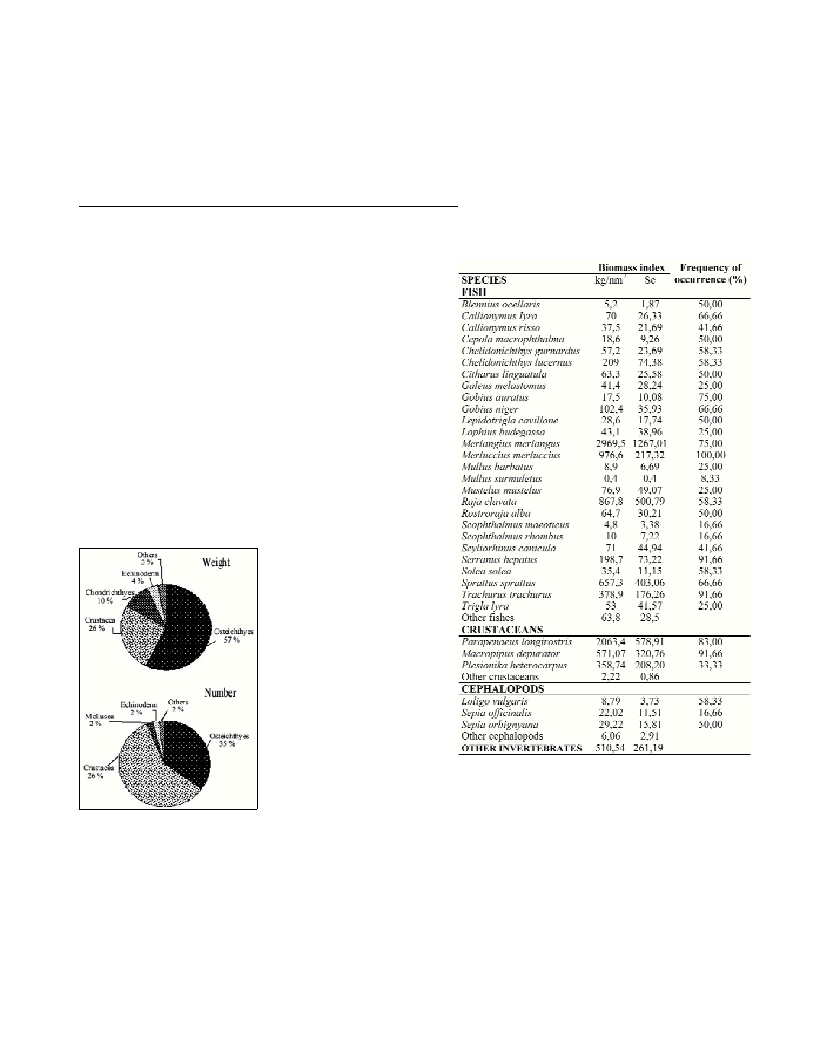THE STATUS OF THE DEMERSAL FISHERIES RESOURCES IN THE MARMARA SEA
F. Saadet Karakulak*, Bayram Öztürk, Bülent Topaloglu, Elif Özgür
Istanbul University, Faculty of Fisheries, Laleli, Istanbul, Turkey
Turkish Marine Research Foundation, Beykoz, Istanbul, Turkey
* karakul@istanbul.edu.tr, ozturkb@istanbul.edu.tr, topalbl@istanbul.edu.tr, eozgur@istanbul.edu.tr
Abstract
A bottom trawl survey was carried out in the Marmara Sea in summer 2001 in order to determine species composition and biomass of
demersal fisheries resources. The average catch was 175.9±34.5 kg/hour (±se) and the average biomass 10,799.7±1,882.9 kg/nm
2
(±se).
Keywords: Bottom-trawl survey, catch composition, biomass, Marmara Sea
Rapp. Comm. int. Mer Médit., 37,2004
378
Introduction
The Marmara Sea, located between two different marine systems,
the Mediterranean Sea and the Black Sea, is important as feeding and
breeding habitat for commercial pelagic species (1). Few studies
concerning the demersal stocks of the Marmara Sea are available (2,
3, 4). The present study evaluates the condition of the demersal fish
stocks of the Marmara Sea and proposes advices for the sustainable
fisheries management in the area.
Materials and Methods
This research was carried out in August 2001, in the Marmara Sea
using a bottom trawl net. The head-rope length of the trawl net was
21.6 m and the cod-end mesh size 20 mm (knot to knot). The duration
of each haul was 30 min at depths up to 200 m and 60 min at depths
>200 m. The trawling speed was 2.2-2.6 nm/hour. Biomass was
calculated based on the swept area method.
Results
A total of 12 hauls were carried out between 30-300 m. The average
catch was 175.9±34.5 kg/hour (±se). The average biomass was
10,799.7±1,882.9 kg/nm
2
or 5,821.1±1,014.6 kg/Km
2
.
From a total of 91 species identified, 34 were osteichthyes, 16
molluscs (4 bivalves, 3 gastropods, 9 cephalopods), 13 echinoderms,
12 crustaceans, 9 chondrichthyes, 6 cnidarians and 1 annelid. The
commercial species comprised 78% of the total catch. Osteichthyes
made up the greatest portion of the catch (by weight: 56.83%; by
number: 34.92%) (Fig. 1).
Discussion
The Marmara Sea is a
very productive fishing
ground for pelagic fishes like
anchovy, pilchard, bonito,
etc. In the Turkish fisheries,
the Marmara Sea ranks
second after the Black Sea as
far as total fish catch is
concerned (5). After the
1980s, the population in-
crease in the Marmara region
was followed by a rapid
urbanized and industrialized
development so that the do-
mestic and industrial waste-
water and unfavourable ha-
bitat conditions affected
fishing grounds negatively,
especially so the water
masses below the thermo-
cline (5). Additionally, fish-
ing pressure on demersal re-
sources increased. For pre-
serving demersal fishing resources, trawling has been prohibited since
the early 1970s. In spite of this, due to the lack of any official control
trawl fishing still continues illegally.
Despite a serious decrease in hake and whiting stocks in 1990-1994
(4), an increase in both stocks was found in this study. The total
amount of whiting catch was 2047 t in 1990, 557 t in 1994 and
2455 t in 2000. The demersal resources of the Marmara Sea might
have positively affected by some protecting measures taken, such as:
(a) the prohibition of the hydraulic dredges used for Chamelea gallina
fishing since 2000, (b) the prohibition of sand extractions and (c) the
establishment of the sewage treatment systems.
The protection of biological diversity in the Marmara Sea and the
sustainable fisheries development could be achieved by: (a) respecting
the fishing prohibitions, especially for the protected species, (b)
limiting fishing effort, (c) protecting shores and (d) using more
selective nets.
References
1-Kocatas, A., Koray, T., Kaya, M., Kara, O.F. 1990. Review of the
fishery resources and their environment in the Marmara Sea. GFCM, 64,
part 3, pp. 87-143, Rome.
2-JICA, 1993. Report of demersal fisheries resource survey in the
Republic of Turkey. JICA, AFF, JR.63, 579p, Ankara.
3-Karakulak, F. S., Tarkan, A. N., Öztürk, B. 2000. Preliminary study on
the demersal fish stocks in the northern Marmara Sea. The Symposium of
Marmara Sea 2000, TUDAV Publications. No.5, pp. 500-512, Istanbul.
4-Okus, E., Yüksek, A., Uysal, A., Orhon, V. 1994. Determination of the
stocks of some commercial demersal fishes in the Marmara Sea project
(1990-1994). Tübitak DEBAG-116/G, I.U. Institute Of Marine Sciences
and Management and T.C. Ministry of Agriculture Rural Affairs.
5-Zengin, M., Mutlu, A. 2000. The resent state of the fisheries and
suggestions related to the future of the stocks at the Marmara Sea. The
Symposium of Marmara Sea 2000, TUDAV Publications. No.5, pp. 411-
425, Istanbul.
Fig. 1. Catch species composition by
number (N) and weight (W).
Table 1. The frequency of occurrence and biomass (in kg/nm
2
) indices
(mean standard error, se) of species caught in the Marmara Sea. Species
are listed alphabetically.

